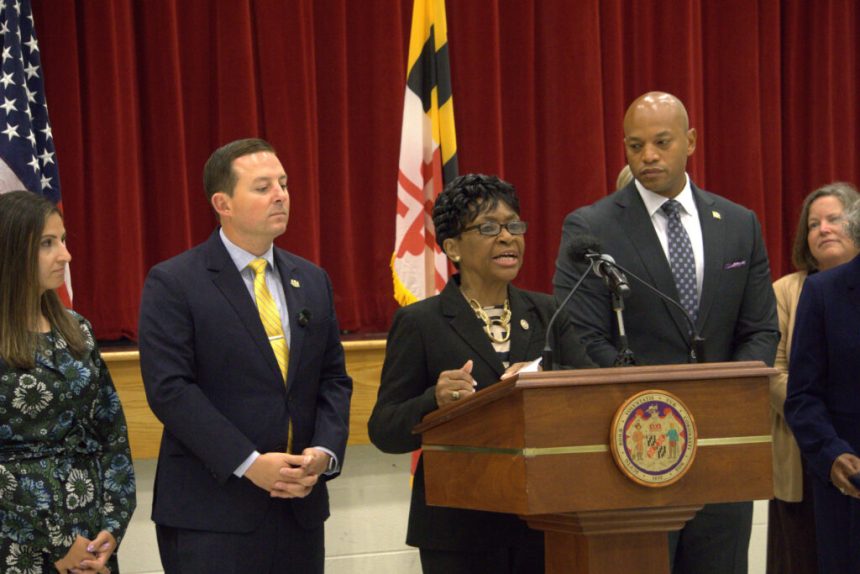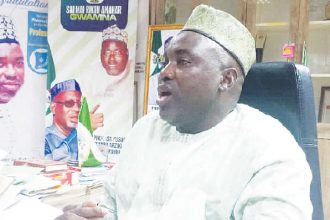Maryland House Speaker Adrienne A. Jones (D-Baltimore County) at a Randallstown news conference last week, flanked by the governor and senate president, who gathered to tout an electricity bill refund heading to customers amid soaring energy costs. (Photo by Christine Condon/ Maryland Matters)
Maryland opened the door Tuesday to a program that could fast-track energy projects through the state’s regulatory process in hopes of boosting the amount of power generated in the state.
For the next 30 days, the Public Service Commission will accept applications for large-scale power projects or “dispatchable” generation, which can provide energy quickly during periods of peak demand.
Selected applicants will get an expedited PSC review that could lead to a Certificate of Public Convenience and Necessity — a green light for construction — in 295 days, or nine to 10 months.
Lawmakers, utilities and energy companies are expected to watch the 30-day application window closely, with Maryland Senate President Bill Ferguson (D-Baltimore City) at an event last week calling it a litmus test for the future of energy generation in Maryland.
“That will be very indicative as to what the market may look like for domestic generation here in Maryland,” Ferguson said. “We will learn a lot from that open auction to see what merchant generators will put forward.”
But few, if any, said they are expecting major new projects to enter the fray, such as a gas-fired power plant, in part because the new law does little to change the challenging economic conditions for the industry.
“It doesn’t change the fundamental economics of building a power plant, right?” said Maryland People’s Counsel David Lapp. “And those economics are probably not good in Maryland, because we’re not near big sources of gas, like in Pennsylvania.”
The expedited review is one part of the energy legislation, called the Next Generation Energy Act, developed by Democratic leadership and pushed through the General Assembly this year in response to high gas and electric bills, amid intense concern from consumers.
Leading lawmakers and Gov. Wes Moore (D) have said they believe that Maryland must generate more energy in-state in hopes of reducing consumers’ bills, as power demand is projected to soar in the 13-state electric grid that includes Maryland — chiefly because of artificial intelligence and data centers.
PSC Chairman Frederick H. Hoover said in a news release Tuesday that the fast-track procedure “provides a pathway to encourage new generation development and improve resource adequacy in Maryland without the State or ratepayers making a financial commitment.”
Moore said in June that he felt the Next Generation Energy Act “didn’t go far enough” to attract new power generation, calling on lawmakers to further incentivize nuclear power in particular. More recently, he has softened his tone.
“I do think the Next Generation [Act] that the General Assembly worked on and passed was an important piece of legislation,” Moore said. “And I do know that we are going to be working together, not just in this next upcoming session, but in this session going forward, to ensure greater relief for our ratepayers.”
Only certain types of power generators are eligible for the expedited review, under the Next Generation Energy Act.
One criterion is Effective Load Carrying Capacity, which measures a resource’s ability to contribute energy to the grid during peak demand periods. Projects seeking fast-track approval must have an ELCC rating at or above 65%, according to the most recent ratings developed by PJM Interconnection, the power grid operator for Maryland and 12 other states. And they also must have greenhouse gas emissions lower than coal or oil.
That list includes nuclear, various types of natural gas-fired power plants, offshore wind, steam and certain types of battery energy storage. The list excludes solar and onshore wind, among other power projects.
But all large-capacity projects — at least 20 megawatts — are eligible, so long as they have also applied to connect to the PJM grid.
Lapp, who represents utility ratepayers, has expressed skepticism that more in-state generation is needed, adding that planned transmission upgrades will ease some of the burden. He argues that most of the projected demand increase from data centers comes from outside Maryland, calling into question the need to impact Marylanders with power plant development.
The 3.2 megawatt Lime Kiln community solar project in Howard County, pictured after a ribbon cutting ceremony on July 8, 2025. (Photo by Christine Condon/Maryland Matters)
Eligible projects currently in PJM’s queue include a large amount of solar projects coupled with battery storage, in addition to a gas plant upgrade, said Evan Vaughan, executive director of MAREC Action, a coalition of utility-scale solar, wind, and battery storage developers in the mid-Atlantic.
“I wouldn’t be surprised if there isn’t a lot of response to this procurement, because we know which projects would be reasonably positioned to respond to it, and I can say on behalf of my members that, generally speaking, the CPCN process has been relatively time-efficient,” Vaughan said. “Utility-scale solar developers are not seeing the CPCN process as the primary barrier to deployment in Maryland.”
Vaughan said some of his members may prefer to apply to a separate solicitation created by the General Assembly, for front-of-the-meter transmission energy storage devices, to be issued by January 2026.
And since state lawmakers gave final approval to the energy package in April, Ferguson noted, the market for renewable energy generators has changed, with passage of President Donald Trump’s “Big Beautiful Bill,” which eliminated substantial Biden-era tax credits for clean-energy projects.
“The evisceration of credits for renewable energy projects has changed the landscape dramatically,” Ferguson said.
Ferguson said that large renewable energy projects are in a “near-halt” position because of the new law, which may force the General Assembly to adjust its strategy.
“That’s something we’re going to have to take into consideration as we approach next session,” Ferguson said. “Now we’re working in a different financial landscape, where half of the energy projects that are the cheapest to build have been taken off the table.”
There could be a short-term increase in the pace of development, Vaughan said, as companies race to begin construction before July 4, 2026, when the tax credits lapse. It’s possible that some developers could try to use the fast-track before the PSC to try and meet that deadline, he said.
“This accelerated CPCN fast-track really could provide a make or break opportunity for those projects to get their CPCN if they feel that they’re at risk,” Vaughan said.









